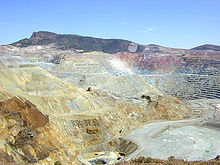Surface mining

Surface mining is a type of mining used to extract mineral deposits that are close to the surface.
In most forms of surface mining, heavy equipment, such as earthmovers, first remove the overburden - the soil and rock above the deposit. Next, huge machines, such as dragline excavators, extract the mineral.
Surface mining generally leaves large devastated areas, called spoil banks, unless the land is reclaimed. Since surface mining removes overlying landscapes, it has a heavy negative effect on human settlements in the area, on local ecosystems, and on the environment.
Types of surface mining
There are four main forms of surface mining, detailed below.
Strip Mining
Strip mining is the practice of mining a seam of mineral ore by first removing all of the soil and rock that lies on top of it (the overburden). It is similar to open-pit mining in many regards.
Strip mining is only practical when the ore body to be excavated is relatively near the surface. This type of mining uses some of the largest machines on earth, including bucket-wheel excavators which can move as much as 12,000 cubic feet of earth per hour. There are two forms of strip mining. The first, and more common one is area strip mining, which is used on fairly flat terrain, to extract deposits over a large area. Contour strip mining, usually used in hilly terrain, involves cutting terraces in mountainsides following the contour of the land.
Among others, strip mining is used to extract the oil-impregnated sand in the Athabasca Tar Sands. It is also common in lignite mining.
Open-pit mining
- For more details, see Open-pit mining

Open-pit mining refers to a method of extracting rock or minerals from the earth by their removal from an open pit or borrow. The term is used to differentiate this form of mining from extractive methods that require tunneling into the earth. Open-pit mines are used when deposits of commercially useful minerals or rock are found near the surface; that is, where the overburden (surface material covering the valuable deposit) is relatively thin or the material of interest is structurally unsuitable for tunneling (as would be the case for sand, cinder, and gravel). Where minerals occur deep below the surface—where the overburden is thick or the mineral occurs as veins in hard rock— underground mining methods are used to extract the valued material. Open-pit mines are typically enlarged until the mineral reserve is exhausted.
Mountaintop removal
Mountaintop removal (MTR) is a relatively new form of coal mining that involves the mass restructuring of earth in order to reach sediment as deep as 1,000 feet below the surface. Mountaintop removal requires that the targeted land be first clear-cut and then leveled by explosives.
Dredging
Dredging is a method often used to bring up underwater mineral deposits. Although dredging is usually employed to clear or enlarge waterways for boats, it can also recover significant amounts of underwater minerals relatively efficiently and cheaply.
